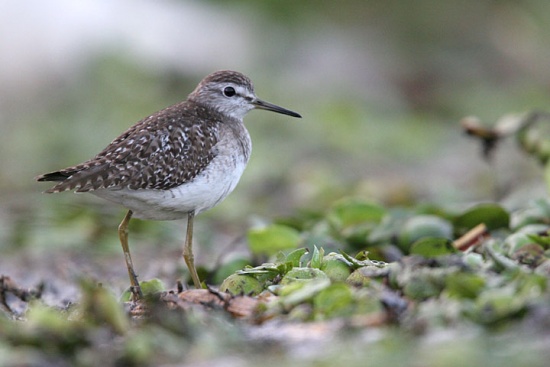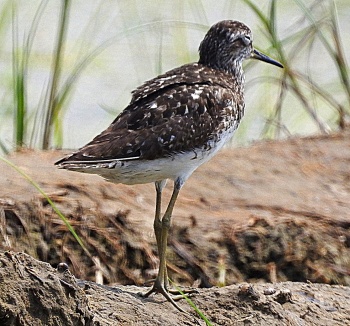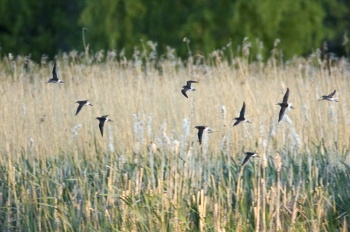m (Move images due to layout problems) |
|||
| (12 intermediate revisions by 4 users not shown) | |||
| Line 1: | Line 1: | ||
| − | + | [[Image:Wood_Sandpiper.jpg|thumb|550px|right|Photo by {{user|Peter+Duymelinc|Peter Duymelinc}}<br />Luxor, [[Egypt]], January 2005 ]] | |
| − | [[Image:Wood_Sandpiper.jpg|thumb|550px|right|Photo by Peter Duymelinc]] | + | ;[[:Category:Tringa|Tringa]] glareola |
| − | == | + | ==Identification== |
| − | The | + | 19–23 cm (7½-9 in)<br /> |
| + | The Wood Sandpiper is a fairly small wader with a rather attenuated 'necky' appearance. It has brown upperparts and generally white underparts. The most striking plumage feature are the bold white supercilia, which show well behind the eye. The supercilia are defined by a dark brown 'cap' and a bold broad eye-stripe. It is quite a 'leggy' bird, not unlike a [[Common Redshank]], though smaller. The legs are usually pale yellowish, but can appear quite dark when the bird is feeding in mud, or in dull light. The bill is about the same length as the head and straight. The head shape is almost squarish in profile, and the neck can be extended or retracted a certain amount, changing the overall appearance. The rump has a square white patch between the dark tip of the tail and the back. | ||
| + | [[Image:wood_sandpiper.jpg|thumb|350px|right|Immature. Photo by {{user|Alok+Tewari|aloktewari}}<br />Delhi, [[India]], July 2016 ]] | ||
| + | ====Similar Species==== | ||
| + | The plumage is not unlike the American [[Lesser Yellowlegs]], though the [[Topography#Heads|supercilia]] are bolder. However, the Lesser Yellowlegs is even more 'leggy' and can remind one of a stilt. | ||
| + | ==Distribution== | ||
| + | Breeds in northern [[Europe]] and northern [[Asia]]; winters in southern [[Africa]], southern [[Asia]] and [[Australia]]. | ||
| + | ==Taxonomy== | ||
| + | This is a [[Dictionary_M-O#M|monotypic]] species<sup>[[#References|[1]]]</sup>. | ||
| − | |||
| − | |||
==Habitat== | ==Habitat== | ||
| + | Wetlands. | ||
==Behaviour== | ==Behaviour== | ||
| − | Wood sandpiper tends to be a rather active bird, often found on the margins of quite small pools, or wading hurriedly through the shallows. It often teeters in the manner of a | + | [[Image:Lirot 11 5.jpg|thumb|350px|right|Photo by {{user|Akihaka|Akihaka}}<br />Salo, [[Finland]], May 2008<br />Click on photo to enlarge]] |
| − | + | Wood sandpiper tends to be a rather active bird, often found on the margins of quite small pools, or wading hurriedly through the shallows. It often teeters in the manner of a [[Common Sandpiper]], though perhaps not quite so frequently. As it advances it pecks briefly to one side or the other, picking up tiny particles of food from the surface of the mud. | |
| − | == | + | ====Diet==== |
| + | The diet includes insects, worms, spiders, shellfish and small fish. | ||
| + | ====Breeding==== | ||
| + | The 4 eggs are are incubated for 22-23 days by the female. The young fledge after 29-31 days. | ||
| + | ====Vocalisation==== | ||
<flashmp3>Tringa glareola (song).mp3</flashmp3><br /> | <flashmp3>Tringa glareola (song).mp3</flashmp3><br /> | ||
''[[Media:Tringa glareola (song).mp3|Listen in an external program]]'' | ''[[Media:Tringa glareola (song).mp3|Listen in an external program]]'' | ||
| + | ==References== | ||
| + | #{{Ref-Clements6thAug15}}#RSPB | ||
| + | #Handbook of the Birds of the World Alive (retrieved May 2014) | ||
| + | #Wikipedia | ||
| + | #BTO Bird Facts | ||
| + | {{ref}} | ||
==External Links== | ==External Links== | ||
{{GSearch|Tringa+glareola}} | {{GSearch|Tringa+glareola}} | ||
| − | + | <br /> | |
| − | + | {{Video|Wood_Sandpiper}} | |
| − | [[Category: | + | |
| + | [[Category:Birds]] [[Category:Tringa]][[Category:Bird Songs]][[Category:Videos]] | ||
Revision as of 11:02, 2 August 2016
- Tringa glareola
Identification
19–23 cm (7½-9 in)
The Wood Sandpiper is a fairly small wader with a rather attenuated 'necky' appearance. It has brown upperparts and generally white underparts. The most striking plumage feature are the bold white supercilia, which show well behind the eye. The supercilia are defined by a dark brown 'cap' and a bold broad eye-stripe. It is quite a 'leggy' bird, not unlike a Common Redshank, though smaller. The legs are usually pale yellowish, but can appear quite dark when the bird is feeding in mud, or in dull light. The bill is about the same length as the head and straight. The head shape is almost squarish in profile, and the neck can be extended or retracted a certain amount, changing the overall appearance. The rump has a square white patch between the dark tip of the tail and the back.
Similar Species
The plumage is not unlike the American Lesser Yellowlegs, though the supercilia are bolder. However, the Lesser Yellowlegs is even more 'leggy' and can remind one of a stilt.
Distribution
Breeds in northern Europe and northern Asia; winters in southern Africa, southern Asia and Australia.
Taxonomy
This is a monotypic species[1].
Habitat
Wetlands.
Behaviour
Wood sandpiper tends to be a rather active bird, often found on the margins of quite small pools, or wading hurriedly through the shallows. It often teeters in the manner of a Common Sandpiper, though perhaps not quite so frequently. As it advances it pecks briefly to one side or the other, picking up tiny particles of food from the surface of the mud.
Diet
The diet includes insects, worms, spiders, shellfish and small fish.
Breeding
The 4 eggs are are incubated for 22-23 days by the female. The young fledge after 29-31 days.
Vocalisation
<flashmp3>Tringa glareola (song).mp3</flashmp3>
Listen in an external program
References
- Clements, J. F., T. S. Schulenberg, M. J. Iliff, D. Roberson, T. A. Fredericks, B. L. Sullivan, and C. L. Wood. 2015. The eBird/Clements checklist of birds of the world: v2015, with updates to August 2015. Downloaded from http://www.birds.cornell.edu/clementschecklist/download/
- RSPB
- Handbook of the Birds of the World Alive (retrieved May 2014)
- Wikipedia
- BTO Bird Facts
Recommended Citation
- BirdForum Opus contributors. (2024) Wood Sandpiper. In: BirdForum, the forum for wild birds and birding. Retrieved 16 April 2024 from https://www.birdforum.net/opus/Wood_Sandpiper
External Links






